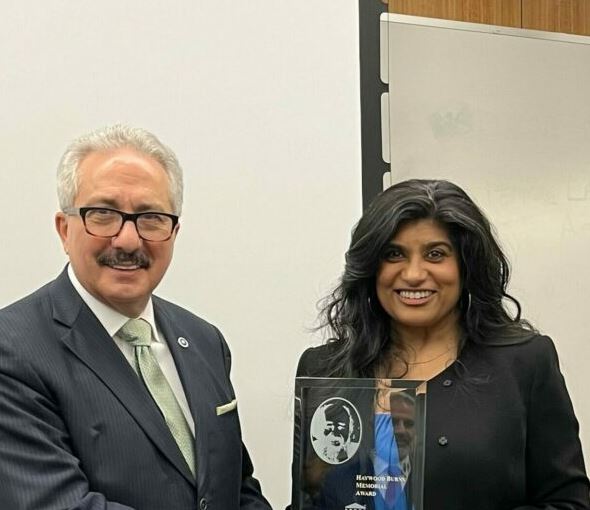The ‘One Family, One Judge’ Court Model: Instituting Integrated Domestic Violence Courts in the United States
3.23.2023

For decades, New York courts have led innovation in the way domestic violence cases are addressed in the United States legal system.[1] Specifically, New York has been at the forefront of instituting specialized courts to handle domestic violence cases, giving courts one focus in handling the endemic of domestic violence.[2] In 1996, the first felony domestic violence court was established in Kings County, operating specifically to handle domestic violence felonies.[3] In the late 1990s, domestic violence courts expanded to include domestic violence misdemeanors as well.[4] Now it is time, past time really, that this approach be adopted nationwide.
There was some resistance to these courts at their origin. Critics were generally skeptical of “problem-solving” courts, which take a holistic approach to a problem instead of focusing only on a legal decision. They complained that judges were turning into social workers or policymakers.[5] Some critics were particularly concerned about judicial neutrality in domestic violence courts.[6] However, there is now “a broad consensus that the primary goals of [domestic violence] court are victim safety and offender accountability.”[7]
In many states, the process of legal separation and protection from an abuser still involves a family court, a criminal court and sometimes more.[8] Even with domestic violence courts, there is a separation of family court cases and criminal court cases, with only the latter belonging in the specialized court.[9]
The Introduction of Integrated Domestic Violence Courts
The Integrated Domestic Violence, or IDV, court system, created in 2001, is an expansion of domestic violence courts, to include not only felony and misdemeanor domestic violence cases but also “related or concurrent Family Court and matrimonial cases.”[10] IDV courts combine civil, criminal and matrimonial courts into one court, with the motto “one family, one judge.”[11] This ensures that domestic violence is handled through both a civil and a criminal lens, all in one court.[12]
The Challenge of Navigating the Court System
Policymakers realized the need for IDV court when they recognized how many families had cases in multiple courthouses simultaneously, including “juvenile corrections, domestic violence, domestic relations, adoptions, and child protection actions.” [13] The Idaho Code explains, “there is a need to coordinate these diverse cases and related family services to provide an effective response to the needs of these children and families.”
In non-IDV jurisdictions, the process for victims of domestic violence involves the undue burden of learning how to navigate several courts’ procedures; hours of filing papers; traveling to different courthouses; and waiting in long lines.[14] In some cases, victims can be so confused and overwhelmed by the different courts that they miss or ignore court notices, which threatens their cases.[15] An abuser can also purposefully delay the court proceedings to “prolong contact” with their victim.[16] Additionally, victims may need to record their stories many times before different judges, which forces victims to relive their trauma and can cause revictimization.[17]
Communication Failings Between Courts
Another problem is the lack of communication between courtrooms.[18] A Family Court judge may be wholly “unaware of relevant criminal data” in a domestic violence case, while the criminal court judge “may not have access to relevant information available in family court files.”[19] The dangers of this lack of communication are numerous, especially pertaining to matters of victim safety and child custody, and can lead to inconsistent orders, such as a partial order of protection issued by one judge and a full order of protection issued simultaneously by another.[20] Retired judge Daniel Angiolillo writes, “Ordinarily there was little communication among the judges presiding over related family court, criminal, and matrimonial cases, and rarely would a criminal court judge exchange information with a family court judge about a related domestic violence case and vice versa.”[21]
Benefits of IDV Court
“The goals of the IDV Court include providing integrated services to families, increased offender accountability, enhanced victim safety, improved court efficiency and consistent judicial making while protecting the rights of each litigant.”[22] The Connecticut General Assembly, citing New York’s Office of Court Administration, lists four main goals: (1) informed and consistent judicial decision-making, protecting the right of each litigation, by having one judge for one family; (2) “efficient use of court resources,” such as fewer appearances; (3) stakeholder collaboration; and (4) victims’ rights/safety.[23]
Court Consistency and Efficiency
To ensure judicial integrity, each IDV case must retain its separate elements: IDV judges often call criminal, family, and matrimonial cases as separate calendars, even if they are all one after the other on the same day, to distinguish the matter at hand, “preserving fundamental due process rights and evidentiary rules.”[24] However, IDV courts can maintain consistency with records and cases with higher efficiency, since there is one judge and one courthouse, with cross-trained attorneys, preventing contradictory decisions by judges with different information.[25]
Impact studies of three IDV courts in different New York counties found a decrease in litigants’ trips to court, which improved convenience for victims and offenders.[26] Fewer pending Family Court cases were outright dismissed in IDV courts; thus, victims were less likely to “come away empty-handed.”[27] The studies also showed an increase in victim safety and offender accountability, particularly through a higher number of criminal contempt charges holding defendants accountable for previous violations of protective orders.[28] Additionally, there was an increase in “mutually favorable” resolutions for families, leading to “fewer subsequent family court filings.”[29] While domestic violence courts “face the issue of insufficiently educated judges and staff dealing with complex and challenging legal and psychological issues,” IDV courts now stress the importance of all staff being educated in the area of domestic violence, with many special trainings for judges, attorneys and other staff members.[30]
Stakeholder Collaboration
Stakeholder collaboration, or community partner involvement, involves different resource groups contributing to the IDV court system beyond the ordinary courtroom staff.[31] The Kings County IDV Court brochure lists a slew of “free civil legal services” that the IDV court collaborates with, often in multiple languages.[32] IDV courts provide that “[v]ictims can . . . petition for an order of protection . . . speak with a counselor, and apply for housing and financial assistance—all while their children play safely in the supervised children’s playroom.”[33] Representatives from stakeholder organizations are consulted in cases and in the boroughs of New York, justice centers are available as victim resources.[34] There is a correlation between continued use of these services and fewer abused children being removed from their abused parents: in areas with an IDV approach, a study found out-of-home placement to be at lower rates than statewide statistics.[35] Additionally, the judge presiding over an IDV court has regularly scheduled stakeholder meetings with “all the participants in the process – police, prosecutors, defense attorneys, family court judges, victim advocates, treatment providers, representatives from the Departments of Health, Probation, Parole, Corrections, Social Services and others – to discuss how to improve systemic performance.”[36]
Victim Safety and Offender Accountability
Research shows that centralizing information through “one family, one judge” increases safety for victims and their families.[37] The four IDV Mentor Courts have proven “records of improving victim safety” by restructuring court logistics, hiring advocates to work for and with the victims and educating courthouse staff on domestic violence.[38] Judges and court staff for an IDV courtroom receive training not only on the unique combination of law that these courthouses involve, but also on domestic violence issues overall, including the dynamics of domestic violence and the impact that it has on children in the home.[39] Additionally, IDV courts provide special waiting rooms for victims before a trial, with security cameras and/or officers, and have courtroom layouts to keep victims separate from offenders.[40]
Enforcing offender accountability goes hand-in-hand with victim safety, such as the inclusion of Compliance Parts.[41] In a study done on the implementation of IDV courts in Tulsa, Oklahoma, the authors note that IDV courts focus on holding offenders accountable with strict but “meaningful” sanctions, with orders that seem “fair” and reasonable, based on the danger presented by the offender, in order to be respected by all parties.[42] A resource coordinator refers defendants in IDV court to services such as batterers’ programs and, if applicable, parenting classes, as well as treatment programs for problems such as substance abuse, which the judge will mandate.[43] These resource coordinators follow up with the programs to get reports on the defendant’s compliance for the court.[44]
The Implementation of IDV Courts
IDV courts are instituted through an administrative order, such as the Order of the Chief Administrative Judge to create IDV parts in New York State Supreme Court in 2004.[45] The New York Codes, Rules and Regulations states: “Following consultation with and agreement of the presiding justice of the Judicial Department in which a county is located, the Chief Administrator, by administrative order, may establish an IDV part in Supreme Court or a DV part in Supreme Court or County Court in such county and assign one or more judges or justices to preside therein.”[46]
Because “multiple actors within the judicial system” are involved in an IDV court, there needs to be advocacy and support for an IDV court to be established.[47] New York has the Center for Court Innovation, for example, which was a key factor in implementing IDV courts in the state.[48] IDV courts require a “buy-in” of the administrative judges and the district attorneys: the consent of these offices to the formation of an IDV court in their jurisdiction.[49] If a district attorney’s office does not want to participate in the IDV court system and refuses to send prosecutors to IDV courts, the criminal cases cannot be integrated.[50] There need to be judges who are passionate about both family law and criminal law and district attorneys who see the benefit of cooperating in sending their assistant DAs to IDV court and conference with the defense attorneys.[51] Judge Esther M. Morgenstern, a pioneer of IDV courts and presiding judge over a National Mentor Court for IDV in the Brooklyn Supreme Court, says that some district attorneys might argue that involvement with the family aspect of IDV is not their responsibility.[52] On the other hand, there are district attorneys like former Kings County District Attorney Charles Hynes, who advocate for an IDV court system because they have a strong interest in protecting domestic violence victims.[53] Other vital players for the implementation of IDV courts include a resource coordinator for victim services; victim advocates; and attorneys cross-trained in criminal and family law, since a primary concern of IDV courts is comprehensive resources for victims, in addition to the legal aspects.[54]
A critical reason that more states have not subscribed to the IDV court system is that it is expensive, says Judge Morgenstern.[55] “We have Safe Horizon in the courtroom, we have a resource coordinator, we have social workers… drug, alcohol programs. . . .”[56] Such resources are integral to IDV courts’ mission of integrated services, bundling all the family’s needs into one, but they come with a high price tag.[57] While New York’s Center for Court Innovation has sent educators into other states, and even other countries, to speak about incorporating IDV courts, there is a reluctance to fund such an expensive project that not all jurisdictions deem necessary.[58] Therefore, it is vital for all organizations interested in protecting and empowering domestic violence victims to advocate for IDV courts in their respective states, and to show state officials that there is a need for these courts.[59] Supporters of the IDV court system can also appeal for grant money from various government departments: for example, in Idaho, the U.S. Department of Health and Human Services funded the Ada County IDV court with a three-year grant starting in 2003 and, in 2005, the U.S. Department of Justice Office on Violence Against Women awarded a grant to the Idaho Supreme Court to expand this model into more counties throughout the state.[60]
Once an IDV court is approved, the IDV Court Model recommends six months of intense planning and six months to implement the twelve necessary components listed under “IDV Court Model Court Components.”[61] The criteria include: training judges and other staff; identifying, screening, and calendaring cases; establishing proper technology and safety features; and organizing domestic violence services and community resources.[62]
Conclusion
The reality is that domestic violence victims suffer long beyond the span of abuse: “Violence by an intimate partner is linked to both immediate and long-term health, social and economic consequences.”[63] While IDV courts may not prevent the lifelong consequences, at the very least, they enable the justice system to provide victims of domestic violence a structure designed to help them.
Elka Blonder is a 3L at the Cardozo School of Law at Yeshiva University focusing on family law and dispute resolution. While an undergraduate English major at Yeshiva University, she interned for Judge Esther Morgenstern in the Kings County IDV court, which was her inspiration for exploring the topic further as a staff editor of the Cardozo Journal of Equal Rights and Social Justice.
This article was an entry in the 2022 Albert S. Pergam International Law Writing Competition sponsored by NYSBA’s International Section. For more information, please see NYSBA.ORG/ILP.
[1] Jennifer Koshan, Investigating Integrated Domestic Violence Courts: Lessons from New York, 51 Osgoode Hall L.J. 989, 1002 (2014).
[2] Id.
[3] Daniel D. Angiolillo, The Integrated Domestic Violence Court: New York’s Successful Experience, Lawyer’s Manual on Domestic Violence: Representing the Victim 150 (Mary Rothwell Davis, Dorchen A. Leidholdt & Charlotte A. Watson eds., 6th ed. 2015).
[4] Id.
[5] Judith S. Kaye and Susan K. Knipps, Judicial Responses to Domestic Violence: The Case for a Problem Solving Approach, 27 W. St. U. L. Rev. 1, 10 (2000).
[6] Michelle Kirby, Integrated Domestic Violence Courts, Old Rsch. Rep., (2016), https://www.cga.ct.gov/2016/rpt/2016-R-0012.htm.
[7] Koshan, supra note 1.
[8] Elizabeth L. MacDowell, When Courts Collide: Integrated Domestic Violence Courts and Court Pluralism, 20 Tex. J. Women & L. 95, 110 (2011).
[9] Amanda B. Cissner, Sarah Picard-Fritsche & Michael Rempel, New York State’s Integrated Domestic Violence Court Model: Results From Four Recent Studies, 1904 Domestic Violence Rep. 51 (2014).
[10] Angiolillo, supra note 3.
[11] Juliana Dalley, “One Family, One Judge”: Towards a New Model for Access to Justice for Families Facing Violence in BC, 18 Appeal 3.
[12] New York State Unified Court System, Integrated Domestic Violence (IDV) Courts, https://ww2.nycourts.gov/COURTS/8jd/idv.shtml.
[13] Idaho Code § 32-1401.
[14] MacDowell, supra note 8.
[15] Deborah Epstein, Effective Intervention in Domestic Violence Cases: Rethinking the Roles of Prosecutors, Judges and the Court System 11 Yale J.L. & Feminism 3, 18 (1999).
[16] Emmaline Campbell, How Domestic Violence Batterers Use Custody Proceedings in Family Courts to Abuse Victims, and How Courts Can Put a Stop to It, 24 UCLA Women’s L. J 41, 42 (2017).
[17] Koshan, supra note 1, at 1009.
[18] Hon. Eugene M. Hyman and Liberty Aldrich, Rethinking Access to Justice: The Need for a Holistic Response to Victims of Domestic Violence, 33 Women’s Rts. L. Rep. 449, 452 (2012).
[19] Id.
[20] Phone call with Hon. Esther M. Morgenstern, Judge, Supreme Court of Kings County, in Brooklyn, N.Y. (Jun. 21, 2022).
[21] 53 Judges’ Journal 10.
[22] The Kings County Integrated Domestic Violence Court, Pamphlet, New York State Unified Court System Office of Policy and Planning 1 (2017 the most precise writing date available) (on file with author).
[23] Kirby, supra note 6.
[24] Integrated Domestic Violence Courts: Key Principles, Center for Court Innovation, https://www.courtinnovation.org/sites/default/files/documents/IDV_FACT_SHEET.pdf.
[25] Dalley, supra note 11, at 15.
[26] Cissner, et al., supra note 9, at 52.
[27] Id.
[28] Id. at 62.
[29] Id. at 63.
[30] Katie Arnold, Jacob Haynes, Nick Ohmann, and Megan Waterman, Cultivating a Successful Future for the Integrated Domestic Violence Court in Tulsa County, University of Tulsa: College of Law 12 (2014), https://law.utulsa.edu/wp-content/uploads/sites/3/2016/04/Cultivating-a-Successful-Future-for-the-IDV-Court.pdf.
[31] Domestic Violence Courts, Idaho Supreme Court, https://web.archive.org/web/20090416062008/https://isc.idaho.gov/links/Domestic%20Violence%20Courts-FINAL.pdf.
[32] The Kings County Integrated Domestic Violence Court, supra note 22, at 4.
[33] Id.
[34] Phone call with Hon. Esther M. Morgenstern, supra note 20.
[35] Epstein, supra note 15. In cases where mothers have psychological damage from being abused, children can be placed into foster care if the court deems the mother unfit to parent. IDV courts have resources in place, such as social work, to heal psychological damage and allow families to remain intact.
[36] 27 W. St. U. L. Rev. 1.
[37] Dalley, supra note 11, at 14.
[38] Arnold et al., supra note 30, at 9–10.
[39] Integrated Domestic Violence Courts: Key Principles, supra note 22
[40] Cissner et al., supra note 9, at 62.
[41] Phone call with Hon. Esther M. Morgenstern, supra note 20.
[42] Arnold et al., supra note 38, at 14.
[43] Integrated Domestic Violence Courts: Key Principles, supra note 24.
[44] Id.
[45] 29 N.Y. Jur. 2d Courts and Judges § 876; N.Y. Comp. Codes R. & Regs. tit. 22 § 141.1.
[46] N.Y. Comp. Codes R. & Regs. tit. 22 § 141.2.
[47] Program Profile: New York Integrated Domestic Violence Courts, National Institute of Justice (2015), https://crimesolutions.ojp.gov/ratedprograms/435#ii.
[48] Interview with Hon. Esther M. Morgenstern, Judge, Supreme Court of Kings County, in Brooklyn, N.Y. (Oct. 18, 2021).
[49] Id.
[50] Id.
[51] Id.; Program Profile: New York Integrated Domestic Violence Courts, supra note 47.
[52] Interview with Hon. Esther M. Morgenstern, supra note 48.
[53] Id.
[54] Program Profile: New York Integrated Domestic Violence Courts, supra note 47.
[55] Interview with Hon. Esther M. Morgenstern, supra note 48.
[56] Id.
[57] The Kings County Integrated Domestic Violence Court, supra note 22.
[58] Interview with Hon. Esther M. Morgenstern, supra note 48.
[59] Id.
[60] Domestic Violence Courts, State of Idaho Judicial Branch, https://isc.idaho.gov/domestic-violence/dvc-court-history.
[61] Program Profile: New York Integrated Domestic Violence Courts, supra note 47.
[62] Id.
[63] Overview of Intimate Partner Violence, National Institute of Justice (2007), https://nij.ojp.gov/topics/articles/overview-intimate-partner-violence.






